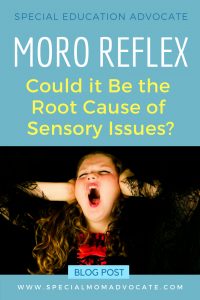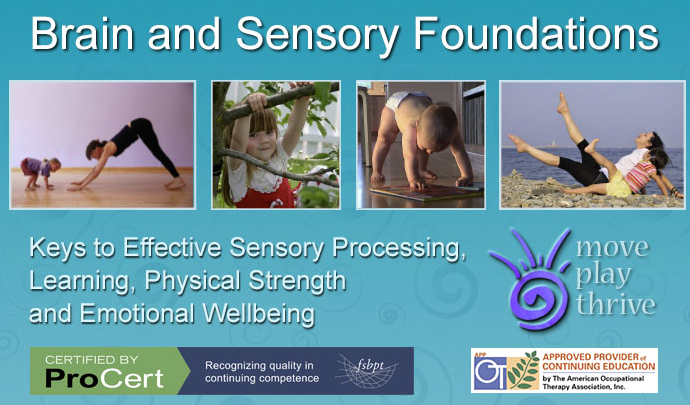The Moro Reflex is a primitive reflex that is generally present when a baby is born. Through repeated body movements the reflex usually integrates at the age of 4 to 6 months. The Moro Reflex is an automatic response to the sudden loss of body support. The infant responds to this falling-like sensation by:
- spreading out he arms
- drawing the arms inward
- crying
Here is a video that shows how the Moro Reflex is stimulated in a baby:
What causes the Moro Reflex?
It is believed that the Moro Reflex is the only unlearned fear in newborn babies. It is usually triggered by a strong sensation such as:
- A loud noise
- Sudden change in light intensity
- A a sudden drop of the body (like when dad throws baby up in the air)
- An unexpected touch
- An change of body position that makes the baby feel unsupported.
This reflex is a good thing for babies. It is thought it is actually a survival mechanism because it causes the baby to grab onto whatever is closest, often the mother. Over a period of 4-6 months the reflex should integrate itself and the baby will no longer respond to the unexpected changes.
What does the Moro Reflex have to do with sensory processing?
Unfortunately sometimes the Moro Reflex does not integrate. This can cause a whole host of issues that can stay with a person through their entire life. It is believed that the Moro Reflex is key to sensory Integration. When present beyond 6 months of age, it can cause hypersensitivity in many areas. It causes the body to stay in permanent survival mode, thus causing hyper vigilance and distraction from everyday tasks such as learning.
Symptoms of an unintegrated Moro Reflex include:
- Exaggerated startle response
- Hypersensitivity to vestibular input
- Hypersensitivity to sound
- Hypersensitivity to touch
- Hypersensitivity to light
- Unable to self-soothe
- Adrenal problems
- Allergies
- Problems with balance
- Dilated pupils
- Motion sickness
What causes an unintegrated Moro Reflex?
In infancy a baby requires movement in order to develop neurologically. If a child is lacking stimulation to trigger the reflex, the brain will not fully develop this neurology. In this way the reflex stay unintegrated, causing constant stress in the body. Trauma and excessive stress can also cause a Moro Reflex to un-integrate, even if it was previously integrated.
How can we integrate the Moro Reflex past infancy?
The good news is you can do specialized movements to help the body integrate the Moro Reflex. Even if you are an adult, you can help your brain develop the wiring to fully integrate this very important response. Sonia Story teaches these methods in our online course, Sensory and Brain Foundations. In this self-paced online class you can learn how to identify which primitive reflexes are unintegrated, and what exercises can be done to integrate them. She will teach you Rhythmic Movement Training, Primitive Reflex Integration and Brain Gym movements that can help with neurological development and calming.
I took this course nearly 10 years ago and it was one of the best things I ever did for my family. Not only did we find that our son had significant issues with unintegrated reflexes, but I found that I also had unintegrated reflexes. Over and over I have referred parent coaching clients to this class, and they were so happy to be able to develop their own program at a fraction of the cost of seeing somebody in a clinic.
By integrating the Moro Reflex we become more calm, less reactive to unexpected events and able to enjoy life’s moments better. There is also greater ability to process sensory information, thus dramatically improvement sensory issues.
Find out more about primary reflex integration course.
ABOUT THE AUTHOR:
Bonnie Landau is a professional counselor and holistic therapist in Ventura County, California. Her specialities include therapy for autism, therapy for ADHD, and therapy for parenting who have kids with autism or ADHD or other neurodivergence. She changed careers from graphic design to counseling with the goal of helping struggling parents of kids with ADHD, autism, or other neurodivergence find strategies and solutions to help their children succeed. Bonnie is also the author of Special Ed Mom Survival Guide: How to Prevail in the Special Education Process and Find Life-long Strategies for You and Your Child.




